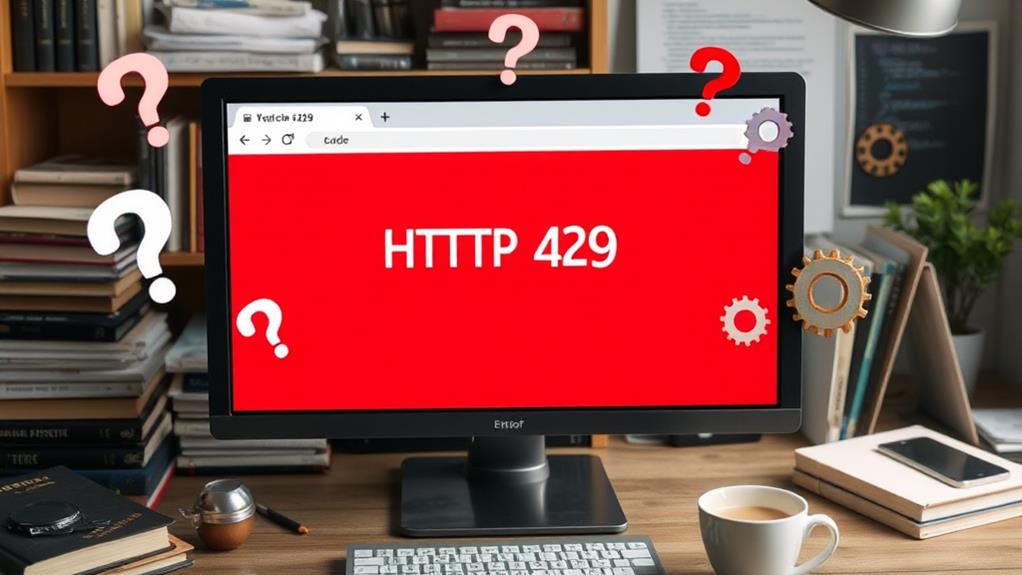HTTP Error 429 occurs when you've exceeded the server's request limit, often due to rapid request patterns or misconfigurations. This can happen with automated scripts, heavy traffic, or poorly optimized applications. To fix it, start by clearing your browser cache and disabling any problematic plugins. Implement throttling to manage request rates effectively. Long-term, consider optimizing your database and monitoring resource usage to avoid overload. Regular maintenance and strong security measures, like rate limiting, play a crucial role too. If you're looking for more strategies to tackle this error, there's plenty more to explore.
Understanding HTTP Error 429
Have you ever encountered an HTTP Error 429 while browsing a website? This error, commonly referred to as "Too Many Requests," occurs when you send more requests to a server than it can manage within a set timeframe. When this happens, the server temporarily denies your access, leading to a temporary denial of service. You might notice a "Retry-After" header, which tells you how long to wait before trying again.
HTTP Error 429 serves as a protective measure for server resources, ensuring that they aren't overwhelmed. High traffic spikes, automated bots, and excessive login attempts can cause this error, as they push the server beyond its limits. When a single IP address sends rapid-fire requests or exceeds API rate limits, it often triggers this safeguard.
Additionally, servers implement these measures to prevent brute force attacks, which can compromise security. It's crucial to maintain strong security measures to protect your site from these types of automated threats.
While encountering this error might feel frustrating, it's important to understand that it's designed to maintain the overall performance of the server, protecting it from overload and ensuring a better experience for all users.
Causes of HTTP Error 429
When you encounter HTTP Error 429, it usually means you're sending requests too quickly for the server to handle.
This excessive request frequency can overwhelm resources, especially if you're hitting API limits or using automated tools.
Additionally, poorly coded themes and plugins can contribute to server strain by making excessive calls, highlighting the importance of vulnerabilities of themes and plugins.
Understanding these causes can help you adjust your approach and avoid running into this frustrating error.
Excessive Request Frequency
Excessive request frequency can quickly lead to HTTP Error 429, signaling that you've hit the server's request limits. This error often occurs when you're sending excessive requests, whether through rapid-fire login attempts or automated scripts.
If you're using APIs, keep in mind that they typically enforce strict rate limits. Exceeding these limits can trigger the HTTP 429 error, which serves as a protective measure against server overload.
In shared hosting environments, the cumulative load from multiple users can exacerbate the issue, resulting in excessive requests being processed simultaneously. Additionally, misconfigured applications or WordPress plugins might inadvertently generate more requests than necessary, pushing the server beyond its capacity.
This can prevent you from accessing your site and frustrate your users.
To fix HTTP 429 errors, you should analyze your request patterns and reduce them as needed. Consider implementing throttling mechanisms to manage request rates effectively.
Also, review any automated processes or plugins you have installed to ascertain they're not creating excessive requests. By addressing these issues, you can help maintain server stability and improve your overall web experience.
Resource Limit Exceedance
HTTP Error 429 can also arise from resource limit exceedance, where a web server's CPU, memory, or other critical resources become overwhelmed. When you experience high traffic or excessive requests, especially in a shared hosting environment, the server resources can quickly become exhausted.
This is because multiple websites share the same resources, making it easier for one site to trigger a 429 error. Poorly optimized databases can exacerbate the situation, demanding more server processing power to handle user requests.
If your site faces brute-force login attempts or DDoS attacks, it can flood the server with requests, leading to rate limiting and, ultimately, HTTP Error 429. Hosting providers often implement specific request rate limits to prevent a single user or IP address from monopolizing server resources.
When these limits are exceeded, the server responds with a 429 status code. To avoid resource limit exceedance, consider optimizing your site's performance, reducing excessive requests, and choosing a hosting plan that can support your traffic needs.
Identifying the Error

Often, users encounter the HTTP Error 429 when they've sent too many requests to a server within a short period. This error typically indicates that you've exceeded the rate limits set by the server or web application.
When your IP address generates rapid-fire requests, it can overwhelm the server's capacity to process them, triggering the error. This problem can also arise from misconfigured settings or incompatible themes and plugins on your WordPress site, which may inadvertently send too many requests, interrupting your service and frustrating users.
Additionally, a sudden spike in traffic, whether from real users or bot activity, can push the server beyond its request handling limits, resulting in the dreaded HTTP Error 429.
When this error occurs, pay attention to the response headers. If you see a "Retry-After" header, it usually suggests a waiting period before you can make more requests.
Understanding these factors can help you identify the cause of the error. By pinpointing the issue, you'll be better equipped to take the necessary steps to fix the error and restore normal functionality on your web hosting platform.
Fixing HTTP Error 429
Encountering the HTTP Error 429 can be frustrating, but there are effective ways to resolve it. Start by clearing your browser cache to eliminate any stored data that might be causing repeated requests to the server.
Additionally, guarantee that your restoration processes follow best practices, as common errors during backup restoration can lead to similar issues. Next, implement exponential backoff strategies; gradually increasing wait times between retry attempts can help prevent overwhelming the server further.
If you're using WordPress, temporarily deactivate all plugins to identify any misconfigurations that could be contributing to excessive request rates.
Monitoring server logs is also essential; look for unusual activity or traffic spikes that may indicate brute-force attacks or other issues leading to the error.
Don't forget to reach out to your hosting provider. They can check for resource limits that may be causing the HTTP 429 errors.
If your current plan can't handle the traffic demands, consider upgrading your hosting plan to accommodate your needs better.
Optimizing Database Performance

A well-optimized database is vital for maintaining a smooth and efficient web experience. A poorly optimized database can greatly increase server load, leading to excessive request handling and triggering HTTP 429 errors. To combat this, you need to focus on regular database maintenance.
Tasks like repairing and optimizing tables via phpMyAdmin can enhance performance and reduce the likelihood of server overload. Additionally, following database creation best practices can help bolster security and efficiency.
Utilizing plugins like Speed Optimizer can help you automate scheduled maintenance and clean unnecessary data, streamlining your database's efficiency. Proper indexing strategies are also important; they enhance query performance and allow the server to handle requests more effectively.
Additionally, monitoring database performance metrics, such as slow queries and resource usage, gives you insights into potential bottlenecks that may lead to HTTP 429 errors. By keeping a close eye on these metrics, you can proactively address issues before they escalate.
Implementing Security Measures
Implementing Security Measures
Robust security measures are essential for safeguarding your website against unwanted traffic and potential threats that can lead to HTTP 429 errors. One effective approach is implementing rate limiting, which controls the number of requests a client can make within a specific timeframe. This helps prevent excessive requests that trigger HTTP status codes like 429.
Additionally, implementing a strong password policy can further enhance your site's defenses against unauthorized access.
Consider using CAPTCHA or reCAPTCHA on your login forms. These tools distinguish between human users and bots, greatly reducing the risk of brute-force attacks that result in HTTP 429 responses.
Changing your default WordPress login URL can also deter automated attack scripts, a common source of excessive request rates.
It's vital to monitor server access logs regularly. This practice allows you to identify and block suspicious IP addresses that may overwhelm your server with requests.
Employing security plugins with firewall features can further protect against unauthorized access attempts and excessive requests from bots.
These combined measures not only enhance security but also lower the chances of encountering those frustrating HTTP 429 errors. By taking these steps, you create a more resilient online presence.
Managing Server Resources

When managing server resources, you need to keep a close eye on CPU and memory usage to stay within your hosting plan's limits.
A minimum of 2GB RAM recommended for smooth WordPress operation can greatly contribute to your site's performance.
By using optimization techniques, like repairing database tables, you can lighten the load on your server and improve response times.
This proactive approach not only enhances performance but also helps prevent those pesky HTTP 429 errors during busy periods.
Resource Usage Monitoring
Effective resource usage monitoring is essential for maintaining server performance and preventing HTTP Error 429. By keeping an eye on your server resources, you can detect excessive request patterns that lead to overload. Most hosting providers offer tools in their control panels that display important metrics such as CPU, memory, and bandwidth consumption. With these insights, you can identify potential bottlenecks before they escalate.
Implementing real-time monitoring solutions is critical. These tools can alert you to sudden spikes in traffic or unusual activity, allowing you to take proactive measures against server strain.
Utilizing access logs is another important strategy; they enable you to track request rates from different IP addresses, helping you identify any malicious activity or bots that might be exhausting your resources.
Don't forget to review and optimize your database performance regularly. Unoptimized databases can greatly increase server load, contributing to HTTP Error 429 occurrences.
Optimization Techniques
Maintaining ideal server performance requires a proactive approach to resource management. By implementing effective optimization techniques, you can greatly enhance your website's performance and reduce the likelihood of encountering HTTP error 429.
Here are four essential strategies to evaluate:
- Optimize Database Maintenance: Regularly maintain your database using tools like Speed Optimizer and phpMyAdmin to repair tables. This reduces server load and improves request handling.
- Implement Caching Mechanisms: Utilize object and page caching to minimize requests. Caching serves stored content, decreasing strain on your server during peak traffic.
- Utilize Content Delivery Networks (CDNs): CDNs distribute server load by caching content closer to users, improving response times and reducing direct hits on your hosting server.
- Update Website Code: Regularly update and optimize your website code by minimizing HTTP requests and compressing files. This can help prevent resource exhaustion that leads to HTTP 429 errors.
Monitoring Traffic Patterns
Monitoring traffic patterns helps you understand the volume and frequency of requests hitting your server, allowing you to identify unusual spikes that could lead to HTTP 429 errors. By analyzing traffic metrics, you can spot trends among unique visitors and their request behaviors.
Implementing effective keyword research and optimization can also aid in understanding user interactions. Tools like Google Analytics and server access logs are invaluable for this purpose, enabling you to track and analyze traffic effectively.
When you notice sudden bursts of requests, particularly from a single IP address, it may indicate a bot attack or a DDoS attempt. Implementing monitoring solutions can alert you to these issues before they escalate, helping safeguard your server performance.
Regularly reviewing these traffic patterns allows you to adjust server resource limits and refine your rate limiting policies proactively. This guarantees your site can handle expected traffic loads without triggering HTTP errors.
You can fine-tune rate limiting and throttling based on historical data, optimizing your server's performance. By staying on top of monitoring traffic patterns, you'll not only mitigate the risk of HTTP 429 errors but also create a smoother experience for all your visitors.
Additional Resources and Tools

When it comes to resolving HTTP Error 429, having the right resources and tools at your disposal can make all the difference. Consider integrating some of these top plugins to enhance your site's performance and security while troubleshooting.
Here are some essential tips to help you troubleshoot effectively:
- Monitoring Tools: Use Google Analytics or server logs to track your API usage and identify traffic spikes that might trigger the error.
- Community Forums: Engage in platforms like Stack Overflow or WordPress support forums for valuable troubleshooting advice and shared experiences from others who've faced similar issues.
- API Management Documentation: Explore best practices on API management to optimize request handling and implement effective rate limits, preventing future errors.
- Rate Limiting Plugins: Consider leveraging plugins that automatically enforce rate limits on your requests. This proactive approach can greatly reduce the chances of encountering a 429 error.
If you continue to face issues, don't hesitate to contact your hosting provider for assistance.
Additionally, clearing your cache may also help resolve temporary glitches.
Conclusion
To sum up, dealing with HTTP Error 429 can be a real pain, like trying to connect to Wi-Fi in a coffee shop that's just too crowded. By understanding its causes and implementing the right fixes—like optimizing your database and managing server resources—you can keep your website running smoothly. Stay vigilant with your traffic patterns and security measures, and you'll avoid those pesky errors. Remember, a little proactive maintenance goes a long way!



